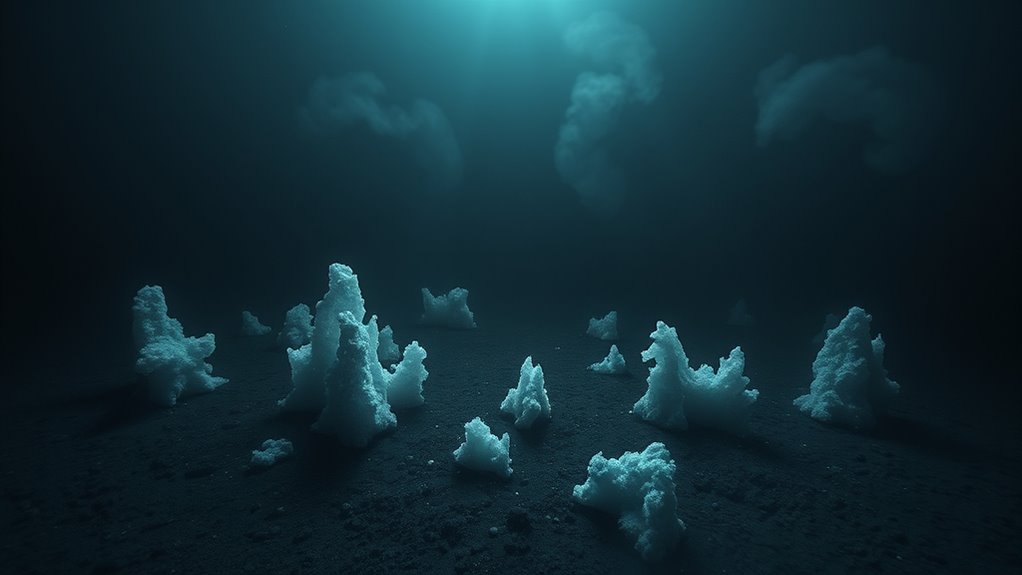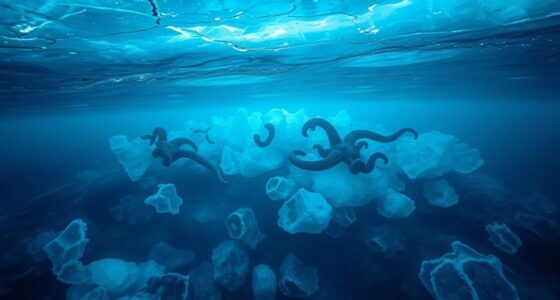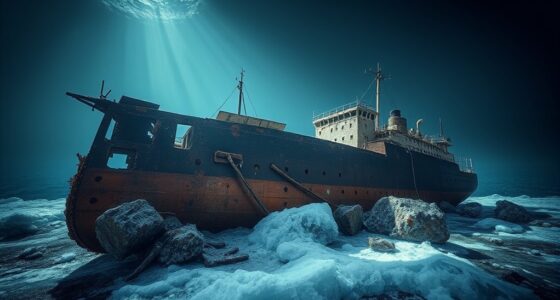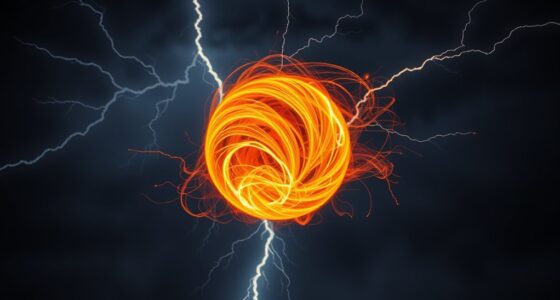Beneath the Bermuda Triangle, vast deposits of methane hydrate sit on the seafloor, hidden dangers that can destabilize the region. These icy compounds trap methane gas and are sensitive to temperature changes, ocean currents, and seismic activity. When destabilized, they can trigger underwater landslides and even tsunamis, threatening both local seafloor stability and global climate. By using advanced mapping tools like seismic surveys and autonomous underwater vehicles, scientists are uncovering these risky zones—if you want to understand how they manage these dangers, stay with us.
Key Takeaways
- Seafloor methane hydrate deposits beneath the Bermuda Triangle pose risks of destabilization and underwater landslides.
- Advanced seismic surveys and autonomous underwater vehicles are used to map and monitor these hydrate-rich areas.
- Destabilized methane hydrates can trigger tsunamis and threaten marine navigation safety in the region.
- Monitoring efforts help predict potential methane releases that impact local ecosystems and global climate.
- Understanding seafloor methane distributions is crucial for safe exploration and mitigating natural disaster risks.

Have you ever wondered what lies beneath the ocean’s surface and how it could pose a threat to our planet? Beneath the waves, vast deposits of methane hydrate—an icy compound trapping methane gas within a crystal lattice of water—sit quietly on the seafloor. These deposits are not just fascinating geological features; they also represent a significant factor in seafloor stability. When disturbed, methane hydrate can rapidly release methane gas, potentially triggering underwater landslides or even tsunamis. That’s why mapping these deposits becomes essential, especially in areas like the Bermuda Triangle, where unpredictable events seem to occur with alarming frequency.
Beneath the ocean, methane hydrate deposits threaten seafloor stability and could trigger devastating underwater disasters.
Methane hydrate forms under specific pressure and temperature conditions, typically found in deep-sea environments. Its stability hinges on these factors, making it a delicate balance. Shifts in temperature, ocean currents, or seismic activity can destabilize hydrate deposits, causing them to dissociate and release methane. This process can weaken the seafloor structure, increasing the risk of slope failure or submarine landslides. Such events could have catastrophic implications—not just locally but globally—by releasing massive amounts of methane into the ocean and atmosphere, intensifying climate change.
To understand and monitor these hazards, scientists employ advanced mapping technologies. They use seismic surveys, gravity measurements, and remote sensing to identify where methane hydrates are concentrated. Subsea robots and autonomous underwater vehicles explore the seafloor, collecting data on sediment composition and stability conditions. Through this meticulous mapping, researchers can pinpoint areas with high hydrate concentrations that might be vulnerable to destabilization. This information is essential for predicting potential natural disasters and for understanding how these deposits might respond to changing ocean conditions.
Your role in this effort involves awareness and support for scientific research. Understanding the delicate balance of seafloor stability and the presence of methane hydrate helps us grasp the potential dangers lurking beneath the surface. It also emphasizes the importance of safe exploration and responsible management of these underwater resources. As climate change accelerates, the risk of hydrate destabilization increases, making it imperative to continue mapping and studying these deposits. By doing so, we gain insight into their behavior, helping to prevent or mitigate future natural disasters.
In essence, mapping dangerous seafloor methane is more than just scientific curiosity. It’s a necessary step toward safeguarding our planet from unexpected events that originate deep beneath the ocean’s surface. Recognizing the link between methane hydrate, seafloor stability, and climate impacts empowers us to make informed decisions about our environment and future security.
Frequently Asked Questions
What Causes Methane to Release From the Seafloor?
You might wonder what causes methane to release from the seafloor. When methane hydrate, a solid form of methane trapped in ice-like structures, becomes unstable, it can break apart. Seafloor fractures and shifting tectonic plates create pathways for methane to escape. As temperatures rise or pressure drops, these processes destabilize the hydrate, releasing methane into the water column, which can then reach the ocean surface or atmosphere.
How Do Scientists Detect Underwater Methane Seeps?
Did you know that scientists have identified over 3,000 methane seeps worldwide? To detect underwater methane seeps, you rely on advanced methods like seismic imaging, which reveals seafloor structures, and underwater sensors that measure methane concentrations directly. These tools help map seep locations accurately, enabling researchers to monitor potential environmental impacts and better understand the role of methane in climate change and seafloor geology.
Can Methane Explosions Occur Suddenly Under the Ocean?
Yes, methane explosions can happen suddenly under the ocean. If methane accumulates in high concentrations and comes into contact with an ignition source, it can trigger a rapid and intense methane ignition. These sudden eruptions release energy quickly, causing underwater bursts. Such events are dangerous because they can destabilize seafloor structures and create shockwaves, which can be mistaken for underwater explosions or even influence nearby marine life and human activities.
What Impact Does Seafloor Methane Have on Global Climate?
Think of seafloor methane as a hidden giant lurking beneath the waves, waiting to influence your climate. When methane hydrate stability is disturbed, it releases methane into the atmosphere, fueling climate feedback loops. This potent greenhouse gas accelerates global warming, making it a significant factor in climate change. Understanding these processes helps you grasp how seafloor methane can amplify warming, impacting ecosystems and weather patterns worldwide.
Are There Any Known Shipwrecks Linked to Methane Hazards?
You might wonder if methane hazards link to shipwrecks. While no direct evidence connects historical shipwreck mysteries to methane eruptions, some theories suggest methane seeps could cause underwater instability, risking ships. Legends of mythical sea monsters might be fueled by methane bubbles or strange sonar readings. Although intriguing, these ideas remain speculative, and no confirmed shipwrecks are definitively tied to methane hazards, but ongoing research keeps the mystery alive.
Conclusion
As you consider the hidden dangers beneath the Bermuda Triangle, remember that scientists have identified over 8,000 square kilometers of seafloor releasing methane. This massive amount could potentially trigger sudden submarine landslides or even contribute to climate change. Knowing these risks, it’s clear that the ocean’s depths hide secrets we must understand better. Staying aware of such dangers helps us protect both maritime safety and our planet’s future.









